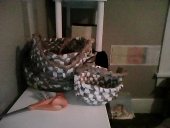
 7
7




“We can complain because rose bushes have thorns, or rejoice because thorn bushes have roses.” — Abraham Lincoln
 4
4




 7
7





Greetings from Brambly Ridge
 7
7




 3
3




 17
17




Idle dreamer
 12
12




 2
2




Tyler Ludens wrote:My husband is making cloches from 1 gallon juice jugs, using a glass scoring jig and a soldering iron.
 6
6




Idle dreamer
 11
11




Catherine Windrose wrote:Thrift shops often have all manner of inexpensive clear glass bottles, candle holders, mason jars, and vases that can be turned upside down to function as a cloche. If you decide to check that out, call first to find when or if there are discounted days. Here there are 50% off days in some of the thrift shops which can make for great shopping.

Pecan Media: food forestry and forest garden ebooks
Now available: The Native Persimmon (centennial edition)
 5
5




I make a Maple Syrup instructional movie! Check it out HERE
SKIP books, get 'em while they're hot!!! Skills to Inherit Property
See me in a movie building a massive wood staircase:Low Tech Lab Movie
 6
6




Mike Haasl wrote:If you cut the bottom off a 1 gallon jug, does the open lid of the jar keep them from overheating during the day? Do you have to put the lid on at night or does it still hold enough heat in?
Pecan Media: food forestry and forest garden ebooks
Now available: The Native Persimmon (centennial edition)
 2
2




 4
4







 6
6




 9
9





 3
3




“We can complain because rose bushes have thorns, or rejoice because thorn bushes have roses.” — Abraham Lincoln
 2
2








“We can complain because rose bushes have thorns, or rejoice because thorn bushes have roses.” — Abraham Lincoln








“We can complain because rose bushes have thorns, or rejoice because thorn bushes have roses.” — Abraham Lincoln
 1
1




 4
4




 5
5




 3
3




 7
7




 5
5




 9
9




There's no right way to do the wrong thing. - Trapper Rick
 4
4




Josephine, Forest Witch
 4
4




 1
1








Jain Anderson wrote:I make use of this concept by recycling gallon milk jugs...quote]
I like how you made those wire protectors -- I've wrestled with making round tops so I could have round bottoms and what a bother that is! Your method of just making rectangular tops and pulling the bottoms out to make them round is perfect! So glad you posted the photo.
Lif Strand
New Mexico USA
 6
6




Best luck: satisfaction
Greatest curse, greed
 1
1




“Peace is not absence of conflict, it is the ability to handle conflict by peaceful means.” —Ronald Reagan
Located in Western West Virginia







Best luck: satisfaction
Greatest curse, greed
 7
7














Tristan Vitali wrote:I have even ditched the need to start tomatoes indoors, which is FREAKING AMAZING here in Maine! After several years of testing, I've found tomatoes started direct-seed under a bottle cloche catch up to and surpass tomatoes transplanted by the first or second week of July most years and there's been no discernible difference in yields."
Added bonus for those of us dealing with slug pressure: by leaving the cap on the bottle until temps are warmed up nicely and the surface has dried a bit, I've found a had a huge decrease in loss of seedlings to those slime balls




 1
1




Nicole Alderman wrote:
Tristan Vitali wrote:I have even ditched the need to start tomatoes indoors, which is FREAKING AMAZING here in Maine! After several years of testing, I've found tomatoes started direct-seed under a bottle cloche catch up to and surpass tomatoes transplanted by the first or second week of July most years and there's been no discernible difference in yields."
When do you sew your tomatoes in the cloche? I planted my seeds in their cloches at the beginning of March, and none in the cider jugs seem to have become seedlings. I have one inside the big lightbulb cover, and one inside the glass window cloches, but nothing inside the cider jugs. I'm not sure why.
I'm not sure if I should try sewing more seeds, or just cut my losses and buy a few more tomato plants. We get a lot of late blight on my property, and we get it as early as August, so I'm trying to get the tomato plants growing sooner so I might get more than a few cherry tomatoes before the blight sets in.

Nicole Alderman wrote:
Added bonus for those of us dealing with slug pressure: by leaving the cap on the bottle until temps are warmed up nicely and the surface has dried a bit, I've found a had a huge decrease in loss of seedlings to those slime balls
I did noticed that I actually have carrot sprouts inside my cloches, while I really don't have any elsewhere. I'm thinking that might be due to protection from slugs!


|
Curse your sudden but inevitable betrayal! And this tiny ad too!
The new permaculture playing cards kickstarter is now live!
https://www.kickstarter.com/projects/paulwheaton/garden-cards
|








